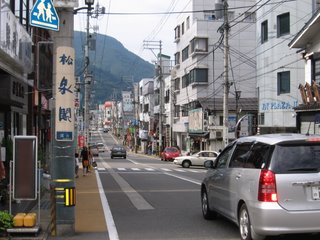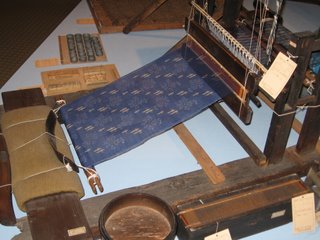Return to Yuzawa, part 1: Ski Suki
~On Monday, I took a trip to one of my favorite places in Japan: the mountain town of Echigo Yuzawa. During the winter ski season, it's a bustling hive of tourists and skiers, but during the summer it's largely empty, and a welcome relief from the sweltering humidity that characterizes summer in Japan. The day was perfect--moderate cloud cover to banish the glaring sun, a cool breeze blowing through the hills, and only a few tourists (such as myself) to get in the way.
 As before, getting to Yuzawa was a snap thanks to Japan's superb system of public transportation. For around $11, I acquired a ticket from a machine (transaction time: 15 seconds), and climbed aboard the train (which left exactly on time). Seriously, I'm being spoiled by this. When I come back to America, I'm going to be appalled that I have to drive everywhere and buy overpriced gas, and submit myself to intense frustration at airports to catch cramped, overpriced planes--
As before, getting to Yuzawa was a snap thanks to Japan's superb system of public transportation. For around $11, I acquired a ticket from a machine (transaction time: 15 seconds), and climbed aboard the train (which left exactly on time). Seriously, I'm being spoiled by this. When I come back to America, I'm going to be appalled that I have to drive everywhere and buy overpriced gas, and submit myself to intense frustration at airports to catch cramped, overpriced planes--Ahem. Anyway, Yuzawa was mostly quiet. The town is filled with gigantic hotels which are now mostly closed. I saw this one under construction:
When I came to Yuzawa before, it was during the transition between the ski season and the summer tourist season, so there wasn't much to do. Now, more things are open and there's more to see. Hoping for a respite from the heat, I ducked into the Yuzawa Museum, a small but blissfully air-conditioned building. It contained exhibits and artifacts from Yuzawa's history stretching back hundreds of years.
 ^ Not being able to read most of the writing, I can only assume that this wickedly-bladed device is some kind of farming implement, perhaps a plow. It can also double as a weapon for fending off hungry bears and equally-hungry samurai.
^ Not being able to read most of the writing, I can only assume that this wickedly-bladed device is some kind of farming implement, perhaps a plow. It can also double as a weapon for fending off hungry bears and equally-hungry samurai. ^ There was also this loom, an interesting example of weaving machinery. It was quite small, though, so I felt as if I was looming over it.
^ There was also this loom, an interesting example of weaving machinery. It was quite small, though, so I felt as if I was looming over it. ^ This purpose of this machine took me some time to deduce. I think it's a rope-making machine: feed two strands of straw in each of the feeders on the right, turn the crank, and it somehow combines them into the rope you can see spooled up on the left. Brilliant!
^ This purpose of this machine took me some time to deduce. I think it's a rope-making machine: feed two strands of straw in each of the feeders on the right, turn the crank, and it somehow combines them into the rope you can see spooled up on the left. Brilliant! ^ I was amazed at what the bygone people of Yuzawa were able to do with straw. They made shoes, coats, roofs and ropes. Here, we have an unusual pair of mittens. Speculation: these are for a) a person who lost eight fingers, b) a mutant with gigantic, two-fingered hands, or c) intended for an animal of some kind. Does anyone have any additional ideas, however far-out they may be?
^ I was amazed at what the bygone people of Yuzawa were able to do with straw. They made shoes, coats, roofs and ropes. Here, we have an unusual pair of mittens. Speculation: these are for a) a person who lost eight fingers, b) a mutant with gigantic, two-fingered hands, or c) intended for an animal of some kind. Does anyone have any additional ideas, however far-out they may be? ^ "Polly put the kettle on, we'll all have tea." Mom, this one's for you!
^ "Polly put the kettle on, we'll all have tea." Mom, this one's for you! ^ A mock-up of a Japanese lady looking out at a past version of Yuzawa. The instrument at the bottom of the picture is a "shamisen", which is a bit like a banjo. You can read all about it in the book "Memoirs of a Geisha" by Arthur Golden, a book that was reasonably enjoyable but which I don't care to read again.
^ A mock-up of a Japanese lady looking out at a past version of Yuzawa. The instrument at the bottom of the picture is a "shamisen", which is a bit like a banjo. You can read all about it in the book "Memoirs of a Geisha" by Arthur Golden, a book that was reasonably enjoyable but which I don't care to read again. ^ Wooden sandals. What makes these interesting is the symbol on them, 〒, which is the symbol of the Japan Post, the national postal system over here. I imagine the post office assigned these sandals to mail carriers a century or so ago. They look quite beat-up, so I'm guessing there's a lot of miles on them. Oops, make that kilometers.
^ Wooden sandals. What makes these interesting is the symbol on them, 〒, which is the symbol of the Japan Post, the national postal system over here. I imagine the post office assigned these sandals to mail carriers a century or so ago. They look quite beat-up, so I'm guessing there's a lot of miles on them. Oops, make that kilometers. ^ A horde of old coins, corroded with age. The cylinders in the back are more rolls of coins. These particular coins resemble modern five- and fifty-yen coins, which have holes in them (I'm not quite sure why this is). I wonder what the adjusted value of this cache is? Here's an image of where the coins came from:
^ A horde of old coins, corroded with age. The cylinders in the back are more rolls of coins. These particular coins resemble modern five- and fifty-yen coins, which have holes in them (I'm not quite sure why this is). I wonder what the adjusted value of this cache is? Here's an image of where the coins came from: ^ Hmm, looks like they dug up someone's not-so-safe deposit box! Let the above photographs be a lesson to all the people saving their money in their mattress or wherever. Remember, "A penny saved is a penny earned" is crap! Inflation means your money will be worth far less in the long term unless you actually invest it in something.
^ Hmm, looks like they dug up someone's not-so-safe deposit box! Let the above photographs be a lesson to all the people saving their money in their mattress or wherever. Remember, "A penny saved is a penny earned" is crap! Inflation means your money will be worth far less in the long term unless you actually invest it in something.On a side note, the unit of Japanese currency is only referred to as the "yen", outside of Japan. Around here, it's called the en (kanji: 円). All money is measured in en; there's no demarcation between dollars and cents or pounds and pence or whatever they're using now in the European Union.
 ^ A set of wooden skis and poles from pre-war times. Seeing these makes me want to ski right now! As I say in Japan, "Ski suki!" (sounds like: ski ski!), which means "I like to ski!". Of course, I'd rather strap something a bit less breakage-prone to my feet. No sense impaling yourself on splintered wood if you can avoid it.
^ A set of wooden skis and poles from pre-war times. Seeing these makes me want to ski right now! As I say in Japan, "Ski suki!" (sounds like: ski ski!), which means "I like to ski!". Of course, I'd rather strap something a bit less breakage-prone to my feet. No sense impaling yourself on splintered wood if you can avoid it. ^ Here we have a set of skis intended for a giant. Japanese giants are reclusive and live deep in the mountains, venturing out only to squash impudent humans and occasionally trade for custom-built equipment large enough for their massive frames. Okay, okay, so these are actually the runners to a wooden sleigh, such as this one:
^ Here we have a set of skis intended for a giant. Japanese giants are reclusive and live deep in the mountains, venturing out only to squash impudent humans and occasionally trade for custom-built equipment large enough for their massive frames. Okay, okay, so these are actually the runners to a wooden sleigh, such as this one:--That's it for tonight. Check back in a day or two for more pictures and occasionally-sarcastic commentary from yours truly. ~Oyasumi!




1 Comments:
Thanks for the teapot photo! I am sipping right now. Maybe the straw "mitts" are for handling hot objects, (but not hot enough to catch them on fire!) What a great museum full of antiques.
Post a Comment
<< Home